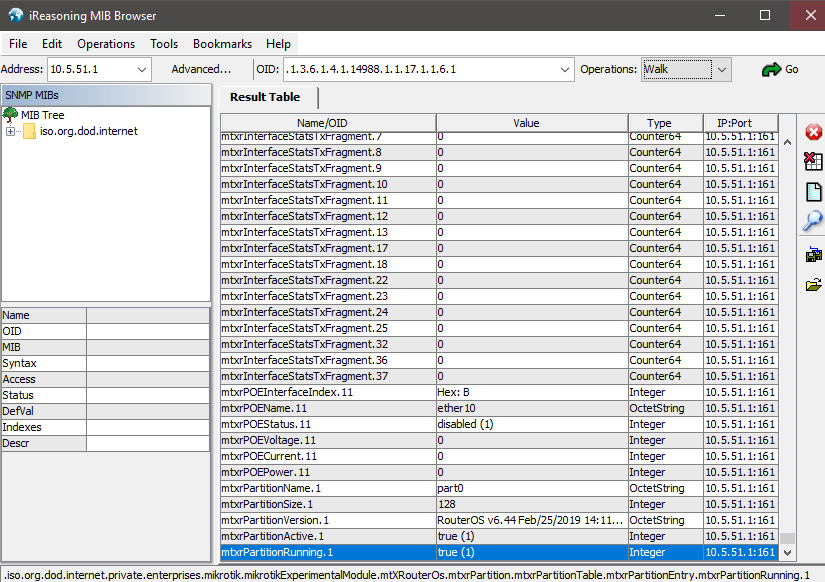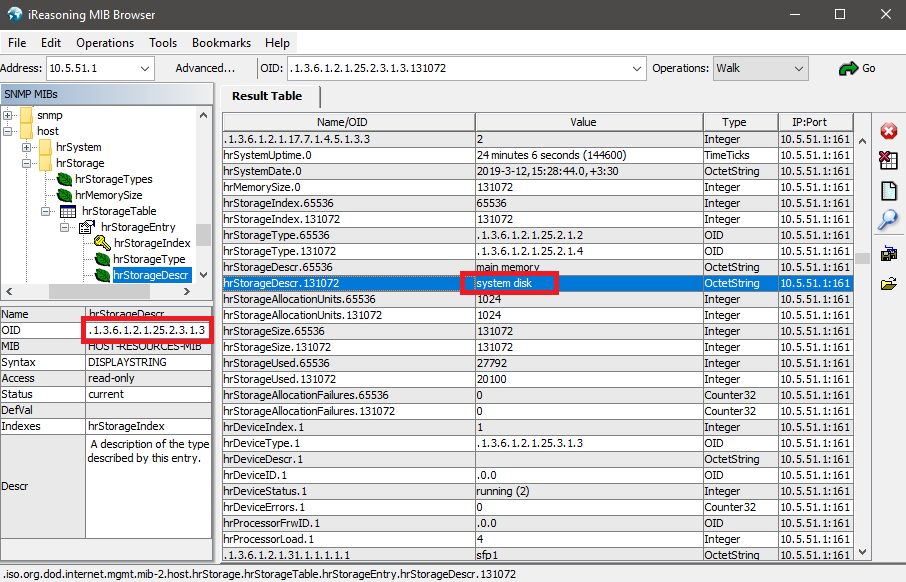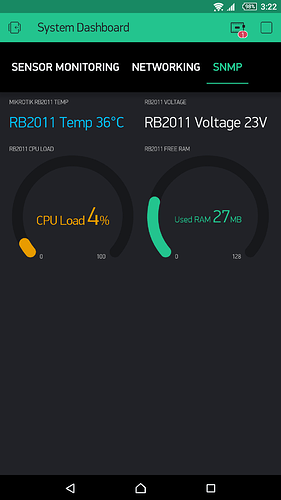Hi friends. here my projects for live monitoring your network devices like Modem/Router etc… with SNMP protocol.
the Library:
https://github.com/Niich/Arduino_SNMP
in this project I’m monitoring the Mikrotik RB2011UiAS-2HnD router. the monitoring parameters I tested is Router voltage, RAM usage, Router temperature and Router CPU load.
the parameters can be read from SNMP OID of your Router/Modem.
first you need to enable the SNMP on your Modem/Router. it’s depending with your Modem/Router model which OID for what ! but don’t worry you can finding the specific OID of your Modem/Router with MIB Browser application. you can download it from here: http://www.ireasoning.com/mibbrowser.shtml
after downloading and installing the MIB browser, run the MIB browser then in the address write your router IP address then from operation select walk to listing all of your Modem/Router OID’s.
then find your own OID you want to monitoring and double click on it to showing the OID. for example I want to monitoring the system disk of my Modem/Router. the OID of my system disk Modem/Router is .1.3.6.1.2.1.25.2.3.1.3 ( it’s different for you ).
finally put this in the arduino sketch to reading the parameters from the blynk app.
snmp.addIntegerHandler(".1.3.6.1.2.1.25.2.3.1.3", &ram, true); //ram usage OID of your router or modem SNMP
and
callbackRA = snmp.findCallback(".1.3.6.1.2.1.25.2.3.1.3", false);
don’t forget to put your Modem/Router IP address in this line in the arduino sketch:
IPAddress netAdd = IPAddress(10,5,51,1);
the sketch:
#include <ESP8266WiFi.h>
#include <BlynkSimpleEsp8266.h>
#include <WiFiUdp.h>
#include <Arduino_SNMP.h>
char auth[] = "81cc3c5ee9754be8ab6fa4a67d8d3be0";
const char* ssid = "MikroTik Tesla";
const char* password = "12345678";
char server[] = "10.5.51.5";
BlynkTimer timer;
unsigned int temp; //value in octets (we are counting them as bytes)
unsigned int volt;
unsigned int cpu;
unsigned int ram;
// initialise objects needed for SNMP
WiFiUDP udp; // UDP object used to send and recieve packets
SNMPAgent snmp = SNMPAgent("public"); // Starts an SMMPAgent instance with the community string 'public'
SNMPGet GetRequestUp = SNMPGet("public", 0); // Starts an SMMPGet instance with the community string 'public'
SNMPGet GetRequestDown = SNMPGet("public", 0); // Starts an SMMPGet instance with the community string 'public'
ValueCallback* callbackTEM;//blank callback pointer. every OID that you want to send a Get-request for needs one
ValueCallback* callbackVOL;
ValueCallback* callbackCP;
ValueCallback* callbackRA;
IPAddress netAdd = IPAddress(10,5,51,1); // IP address object of the device you want to get info from
void setup()
{
// put your setup code here, to run once:
Serial.begin(115200);
Blynk.begin(auth, ssid, password, server, 8080);
Serial.println("");
// Wait for connection
while (WiFi.status() != WL_CONNECTED)
{
delay(500);
Serial.print(".");
}
Serial.println("");
Serial.print("Connected to ");
Serial.println(ssid);
Serial.print("my IP address: ");
Serial.println(WiFi.localIP());
snmp.setUDP(&udp);// give snmp a pointer to the UDP object
snmp.begin();// start the SNMP listener
snmp.beginMaster(); // start the SNMP sender
// OID for temp
snmp.addIntegerHandler(".1.3.6.1.4.1.14988.1.1.3.10.0", &temp, true); // temperature OID of your router or modem SNMP
// OID for volt
snmp.addIntegerHandler(".1.3.6.1.4.1.14988.1.1.3.8.0", &volt, true); //voltage OID of your router or modem SNMP
// OID for cpu
snmp.addIntegerHandler(".1.3.6.1.2.1.25.3.3.1.2.1", &cpu, true); //cpu usage OID of your router or modem SNMP
// OID for ram
snmp.addIntegerHandler(".1.3.6.1.2.1.25.2.3.1.6", &ram, true); //ram usage OID of your router or modem SNMP
//Create the call back ID's you will need to pass to the SNMP function
callbackTEM = snmp.findCallback(".1.3.6.1.4.1.14988.1.1.3.10.0", false);
callbackVOL = snmp.findCallback(".1.3.6.1.4.1.14988.1.1.3.8.0", false);
callbackCP = snmp.findCallback(".1.3.6.1.2.1.25.3.3.1.2.1", false);
callbackRA = snmp.findCallback(".1.3.6.1.2.1.25.2.3.1.6", false);
timer.setInterval(1000L, getSNMP);
}
void getSNMP(){
//check to see if it is time to send an SNMP request.
//if you send requests to often it seens to cause some issues
//see the results of the get-request in the serial monitor
Serial.print("temp: ");
Serial.print(temp);
Blynk.virtualWrite(V12, temp / 10);
Serial.println();
Serial.print("volt: ");
Serial.print(volt);
Blynk.virtualWrite(V13, volt / 10);
Serial.println();
Serial.print("cpu: ");
Serial.print(cpu);
Blynk.virtualWrite(V14, cpu);
Serial.println();
Serial.print("ram: ");
Serial.print(ram);
Blynk.virtualWrite(V15, ram / 1000);
Serial.println();
Serial.println("----------------------");
//build a SNMP get-request
GetRequestDown.addOIDPointer(callbackTEM);
GetRequestDown.setIP(WiFi.localIP()); //IP of the arduino
GetRequestDown.setUDP(&udp);
GetRequestDown.setRequestID(rand() % 5555);
GetRequestDown.sendTo(netAdd); //IP of the remote client
GetRequestDown.clearOIDList();
snmp.resetSetOccurred();
GetRequestUp.addOIDPointer(callbackVOL);
GetRequestUp.setIP(WiFi.localIP());
GetRequestUp.setUDP(&udp);
GetRequestUp.setRequestID(rand() % 5555);
GetRequestUp.sendTo(netAdd);
GetRequestUp.clearOIDList();
snmp.resetSetOccurred();
GetRequestDown.addOIDPointer(callbackCP);
GetRequestDown.setIP(WiFi.localIP());
GetRequestDown.setUDP(&udp);
GetRequestDown.setRequestID(rand() % 5555);
GetRequestDown.sendTo(netAdd);
GetRequestDown.clearOIDList();
snmp.resetSetOccurred();
GetRequestUp.addOIDPointer(callbackRA);
GetRequestUp.setIP(WiFi.localIP());
GetRequestUp.setUDP(&udp);
GetRequestUp.setRequestID(rand() % 5555);
GetRequestUp.sendTo(netAdd);
GetRequestUp.clearOIDList();
snmp.resetSetOccurred();
}
void loop() {
Blynk.run();
timer.run();
snmp.loop();
}
the screenshot:
Good luck 



 But I succeeded
But I succeeded 
